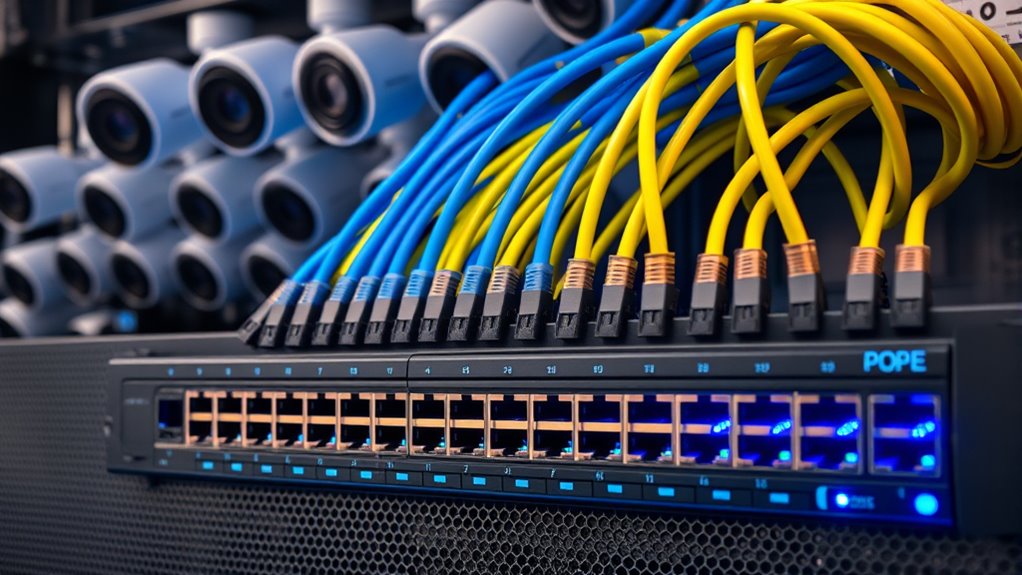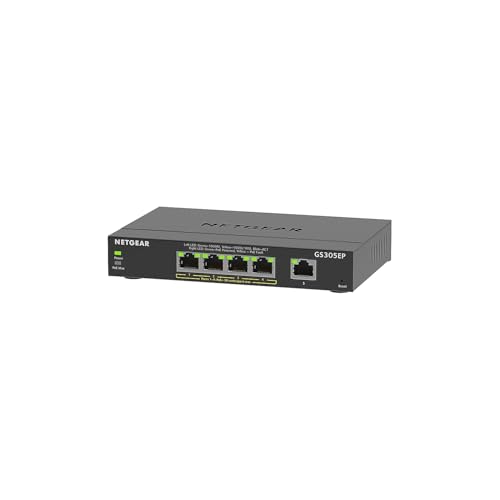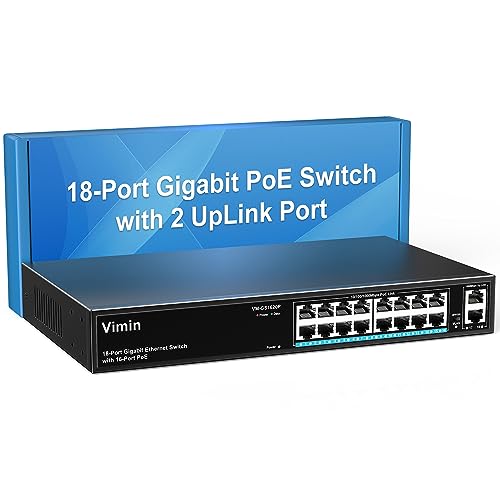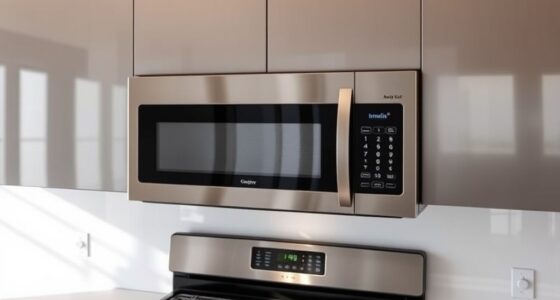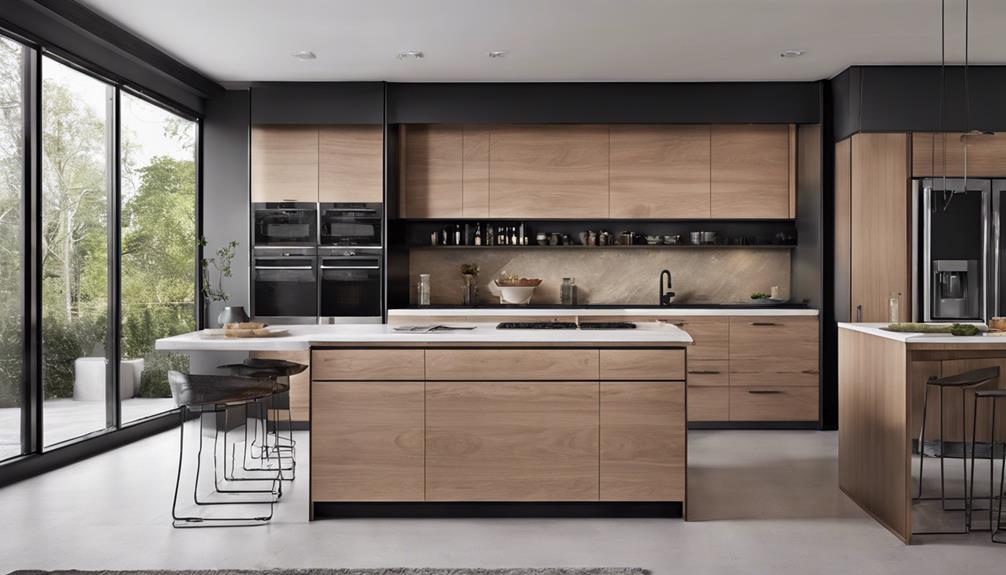If you’re looking for the best PoE network switches for cameras in 2025, I recommend considering models from NETGEAR, REOLINK, TP-Link, and BV-Tech, which offer reliable power and seamless connectivity. These switches come with various port options, support high PoE budgets, and include gigabit uplinks for fast data transfer. Choosing the right switch depends on your network size and device needs. Keep exploring to discover more about top options and their features to guarantee your surveillance system is flawless.
Key Takeaways
- Prioritize switches with high PoE power budgets (e.g., 150W–800W) to support multiple high-power cameras like PTZ and 4K models.
- Choose models with Gigabit Ethernet ports and SFP options for fast, reliable data transfer and extended network reach.
- Opt for managed switches with VLAN, QoS, and remote monitoring features for better network control and video quality.
- Select durable, fanless, and industrial-grade switches for outdoor or demanding environments to ensure long-term reliability.
- Ensure compatibility with IEEE 802.3af/at standards for seamless integration with various camera types and future scalability.
NETGEAR 5 Port PoE Gigabit Ethernet Switch (GS305EP)
If you’re looking for an affordable, reliable PoE switch suitable for small networks or home setups, the NETGEAR GS305EP is an excellent choice. It offers five gigabit ports, with four supporting PoE+ and a total power budget of 63W, perfect for devices like IP cameras, VoIP phones, and access points. Its compact design fits easily on desktops or walls, and it operates silently, making it ideal for noise-sensitive environments. The switch features a simple web GUI for basic management, including VLANs and QoS. Overall, it provides stable performance, easy setup, and solid power delivery, making it a great option for small-scale networking needs.
Best For: small businesses, home offices, or anyone needing an affordable, easy-to-manage PoE switch for powering IP cameras, VoIP phones, and access points.
Pros:
- Easy to set up with a user-friendly web GUI
- Compact and silent design suitable for noise-sensitive environments
- Reliable gigabit performance with PoE+ support for common network devices
Cons:
- Limited VLAN management and absence of CLI for advanced configuration
- Management software restricts remote access across different networks
- Basic features lacking advanced QoS options and extensive VLAN controls
REOLINK PoE Switch with 8 PoE and 2 Gigabit Uplink Ports
Looking for a reliable PoE switch that simplifies your camera setup? The REOLINK PoE Switch offers 8 PoE ports (10/100Mbps) and 2 Gigabit uplink ports (10/100/1000Mbps). It’s compatible with IEEE802.3af/at standards, making it perfect for REOLINK NVRs and PoE IP cameras. With a 120W power budget, it supplies up to 30W per port and uses intelligent power management to prevent overloads. The switch automatically detects PoE devices, powering only compatible ones for safety. Its plug-and-play design allows easy installation on walls or desktops, making it ideal for diverse environments and quick network expansion.
Best For: users seeking a reliable, easy-to-install PoE switch for security camera setups and network expansion in various environments.
Pros:
- Supports up to 8 PoE devices with a total power budget of 120W, ideal for multiple cameras and devices
- Intelligent power management prevents overloads and ensures safety for all connected devices
- Plug-and-play design allows quick installation on walls or desktops without complex configuration
Cons:
- Limited to 10/100Mbps for PoE ports, which may be slower for some high-bandwidth applications
- Requires compatible PoE devices; non-PoE devices need additional power sources
- No additional advanced features such as VLAN support or network management tools
TP-Link 5 Port Fast Ethernet PoE Switch
The TP-Link 5 Port Fast Ethernet PoE Switch stands out as an ideal choice for small to medium-sized surveillance setups, thanks to its four PoE+ ports supporting up to 30W each. It offers effortless plug-and-play installation with auto-negotiation and auto MDI/MDIX, ensuring seamless connectivity. With a total power budget of 67W, it reliably powers IP cameras, access points, and IP phones over a single cable. Its sturdy metal case, fanless design, and compact size make it suitable for various environments. Plus, the 3-year warranty and free support provide added peace of mind for long-term surveillance needs.
Best For: small to medium-sized surveillance setups requiring reliable power and data transfer for IP cameras, access points, and IP phones.
Pros:
- Supports four PoE+ ports delivering up to 30W each for powering multiple devices over a single cable.
- Plug-and-play setup with auto-negotiation and auto MDI/MDIX for easy connectivity.
- Durable metal case with fanless design ensures quiet operation and suitability for various environments.
Cons:
- Total power budget of 67W may limit the number of high-power devices connected simultaneously.
- Data transfer rate limited to 100 Mbps per port, which may be insufficient for high-bandwidth applications.
- No managed features or advanced network configurations, restricting customization for complex networks.
REOLINK PoE Switch with 8 PoE and 2 Gigabit Uplink Ports
Designed for small to medium surveillance setups, the REOLINK PoE Switch with 8 PoE ports and 2 Gigabit uplink ports stands out by offering reliable power and data transmission in a compact form. It supports IEEE802.3af/at standards and is compatible with REOLINK RLN36 NVR and PoE IP cameras. With up to 30W per port and a total of 120W, it intelligently manages power, preventing overloads. Its auto-detection guarantees power is only supplied to compatible devices, enhancing safety. Easy to install with a plug-and-play design, it can be mounted on walls or desktops, making it versatile for various environments.
Best For: small to medium surveillance system users seeking reliable PoE power and easy setup for IP cameras and network expansion.
Pros:
- Supports IEEE802.3af/at standards for broad compatibility with PoE devices.
- Intelligent power management prevents overloads and ensures device safety.
- Plug-and-play design allows quick installation with minimal configuration.
Cons:
- Limited to 10/100Mbps on PoE ports, which may be slower than gigabit for data transfer.
- Only supports up to 8 PoE devices, which might be insufficient for larger setups.
- Requires a power source for operation, adding an extra component to setup.
TP-Link TL-SG1005P 5-Port Gigabit PoE Switch
If you’re setting up a camera network that demands reliable power and high-speed data transfer, the TP-Link TL-SG1005P offers a standout solution with its 4 PoE+ ports supporting 802.3at/af standards. Each port delivers up to 30W, with a total PoE power budget of 65W, ensuring your cameras stay powered without extra outlets. The switch also includes a non-PoE Gigabit port for fast data transfers. Its plug-and-play design makes setup quick and simple, while features like QoS and IGMP Snooping optimize multimedia performance. Built with a sturdy metal case and fanless operation, it’s ideal for quiet, reliable network environments.
Best For: small to medium-sized networks requiring reliable gigabit connectivity with PoE support for powering devices like IP cameras and VoIP phones.
Pros:
- Supports 4 PoE+ ports with up to 30W per port, ideal for powering multiple devices simultaneously.
- Easy plug-and-play setup with no software configuration needed, saving time and effort.
- Durable metal construction with fanless design ensures silent operation and long-lasting performance.
Cons:
- Limited to 5 ports, which may not suffice for larger network setups.
- Total PoE budget of 65W might be insufficient for high-power devices requiring more power.
- No additional advanced management features like VLAN or SNMP for enterprise-level control.
TP-Link LS108GP 8-Port PoE Gigabit Ethernet Switch
For those looking to deploy surveillance cameras over a wide area, the TP-Link LS108GP stands out with its extended PoE transmission capability of up to 820 feet. This 8-port PoE+ gigabit switch delivers reliable power and seamless connectivity, ideal for large outdoor or industrial setups. Its durable metal case and fanless design ensure quiet operation in noise-sensitive environments. With a total PoE budget of 65W and auto-recovery features, it guarantees stable power delivery and network stability. Plus, its plug-and-play setup makes installation straightforward. Overall, the LS108GP offers a perfect blend of power, range, and ease of use for extensive camera networks.
Best For: small to medium-sized businesses or outdoor surveillance deployments needing reliable PoE power and extended transmission range for cameras.
Pros:
- Supports extended PoE transmission up to 820 feet, ideal for large-area camera coverage
- Durable metal case with silent, fanless operation suitable for noise-sensitive environments
- Easy plug-and-play setup with auto-recovery features for stable network management
Cons:
- Limited total PoE power budget of 65W, which may restrict the number of high-power devices connected simultaneously
- No advanced configuration options or managed switch features for network customization
- Slightly larger footprint may require wall mounting or desktop space considerations
STEAMEMO 8-Port Gigabit PoE Switch
The STEAMEMO 8-Port Gigabit PoE Switch stands out with its reliable plug-and-play setup and robust power capabilities, making it an excellent choice for security camera systems. Its unmanaged metal casing offers durability, and the options for desktop or wall-mount installation add flexibility. With 8 Gigabit PoE ports supporting IEEE 802.3af/at up to 30W per port and a total power budget of 120W, it efficiently powers multiple devices. The switch features intelligent PoE detection to prevent damage and optimize power use, along with VLAN and lightning protection for enhanced network stability and safety. Its silent, fan-less design ensures quiet, hassle-free operation.
Best For: small to medium-sized businesses or home security setups needing reliable, easy-to-manage PoE network switches.
Pros:
- Plug-and-play setup with no software configuration required for quick installation.
- Supports IEEE 802.3af/at standards with intelligent PoE detection, preventing damage to non-PoE devices.
- Robust metal casing with fan-less design ensures silent operation and durability.
Cons:
- Limited to unmanaged functionality; lacks advanced network management features.
- Only 8 ports, which may be insufficient for larger network expansions.
- No included power supply, requiring an external 48V DC power source for operation.
STEAMEMO PoE+ Switch, 8 Port Managed Ethernet Switch
The STEAMEMO PoE+ Switch with 8 managed ports stands out as an ideal choice for small businesses and home security setups seeking reliable, high-power PoE connectivity. With 8 ports delivering up to 30W each and a total PoE budget of 120W, it easily powers cameras, smart devices, and IoT gear. Its advanced features—VLAN, QoS, security protocols, and dual-mode operation—offer flexible network management. Rugged and compact, it’s built for durability, silent operation, and simple installation. Managed via web, app, or software, it provides real-time monitoring and remote control. Overall, it’s a versatile, dependable switch suited for various indoor environments.
Best For: Small businesses, home security setups, and IoT enthusiasts seeking reliable PoE+ power and network management in a compact, durable switch.
Pros:
- Supports high-power PoE+ with up to 30W per port and a total budget of 120W, ideal for powering cameras and smart devices.
- Features advanced management tools like VLAN, QoS, security protocols, and remote monitoring options for flexible network control.
- Rugged metal construction with fanless design, advanced heat dissipation, and lightning protection ensures durability and silent operation.
Cons:
- Lacks rack-mounting ears, which may limit installation options in certain network cabinets.
- Limited gigabit speeds (only 100Mbps ports), which might be a constraint for high-bandwidth applications.
- Some users report limited testing under high data loads, so performance in intensive environments may vary.
TP-Link TL-SG116P 16-Port Gigabit PoE Switch
If you’re setting up a surveillance system or expanding your network with PoE-powered devices, the TP-Link TL-SG116P 16-Port Gigabit PoE Switch stands out as a reliable and efficient choice. It offers 16 gigabit ports, supporting PoE+ with up to 30W per port and a total power budget of 120W. Its fanless design guarantees silent operation, and features like QoS, IGMP snooping, and plug-and-play setup make deployment straightforward. With a compact metal case and support for long-distance transmission, it’s perfect for powering multiple cameras and access points in various environments. Plus, the 3-year warranty and positive reviews reinforce its reputation for dependability.
Best For: small to medium-sized businesses or home networks seeking a reliable, high-performance PoE switch for surveillance, access points, and network expansion.
Pros:
- Supports 16 gigabit ports with PoE+ up to 30W per port, ideal for powering multiple devices.
- Fanless design ensures silent operation, suitable for noise-sensitive environments.
- Easy plug-and-play setup with advanced features like QoS and IGMP snooping for optimized network performance.
Cons:
- Limited total PoE power budget of 120W may restrict the number of high-power devices connected simultaneously.
- No built-in management interface, which may limit advanced network configuration options.
- Operating at 57V DC requires compatible power sources, potentially complicating certain installations.
NETGEAR 8 Port PoE Gigabit Ethernet Switch
For those seeking a reliable and easy-to-manage switch for their camera network, the NETGEAR 8 Port PoE Gigabit Ethernet Switch stands out with its intuitive management features and solid power budget. It offers 8 Gigabit Ethernet ports, all PoE+ capable, with a total power of 62W—perfect for powering IP cameras, VoIP phones, or access points. Its Easy Smart Managed Essentials software provides straightforward configuration, security, and monitoring. Plus, it supports both desktop and wall-mount setups, making installation flexible. Backed by a 3-year warranty, this switch combines simplicity, performance, and dependability for any surveillance or network expansion in 2025.
Best For: small to medium-sized businesses or home surveillance setups seeking a reliable, easy-to-manage PoE switch for powering IP cameras, VoIP phones, and access points.
Pros:
- Easy Smart Managed Essentials software offers straightforward configuration and monitoring
- Supports 8 PoE+ ports with a total power budget of 62W for multiple devices
- Flexible installation options include desktop placement and wall mounting
Cons:
- Limited to basic managed features, lacking advanced network management capabilities
- Power budget may be insufficient for high-power PoE devices or large deployments
- No built-in network security features beyond basic configuration
YuanLey 48 Port Gigabit PoE Switch Unmanaged
Designed for large-scale surveillance setups, the YuanLey 48 Port Gigabit PoE Switch Unmanaged offers an impressive 800W power budget and 48 PoE+ ports, making it ideal for powering multiple IP cameras simultaneously without the need for extra power supplies. Its industrial-grade design includes a sturdy metal rackmount housing, lightning protection, and an operating temperature range from -10°C to +55°C, ensuring durability in various environments. With a 56Gbps switching capacity and plug-and-play setup, it simplifies installation across homes and businesses. Plus, its reliable performance is backed by rigorous testing, a one-year warranty, and lifetime support.
Best For: small to medium-sized businesses and security installations requiring reliable, high-power PoE connectivity for multiple IP cameras and network devices.
Pros:
- High 800W PoE power budget supports many devices simultaneously.
- Robust industrial-grade design with lightning protection and wide temperature range.
- Easy plug-and-play setup with auto device detection simplifies installation.
Cons:
- Unmanaged switch lacks advanced features like VLAN or traffic prioritization.
- No PoE passthrough or additional management capabilities.
- Fixed port configuration may limit flexibility for future network upgrades.
16 Port Gigabit PoE Switch with 2 Uplink Ports
A Port Gigabit PoE Switch with 2 Uplink Ports is an excellent choice for small to medium-sized camera setups that require reliable high-speed connections. It offers 16 Gigabit PoE+ RJ45 ports and 2 uplink ports, supporting data transfer at 1000 Mbps. With IEEE 802.3af/at standards, it delivers up to 30W per port and a total power budget of 250W, perfect for powering multiple high-power devices like IP cameras. Its plug-and-play design, compact metal housing, and VLAN support make installation simple and flexible, ensuring secure and stable network performance. This switch balances power, speed, and ease of use for most surveillance needs.
Best For: small to medium-sized surveillance setups needing reliable high-speed PoE connections for multiple IP cameras and network devices.
Pros:
- Supports 16 Gigabit PoE+ RJ45 ports with up to 30W per port, ideal for high-power devices.
- Features VLAN support for enhanced network security and port isolation.
- Compact, durable metal housing with plug-and-play design for easy installation in various environments.
Cons:
- Some units may experience hardware issues such as faulty ports or reconnection problems.
- Limited documentation can make initial configuration, especially VLAN setup, challenging.
- Power capacity discrepancies (120W vs. 95W) might require verification before purchase.
8 Port Gigabit PoE+ Switch with Rack Mount
If you’re setting up a professional surveillance system or need a reliable network backbone, an 8-port Gigabit PoE+ switch with rack mount capabilities offers an excellent balance of power, speed, and expandability. It provides eight PoE+ ports supporting up to 30W each, ideal for IP cameras and VoIP phones, with two additional Gigabit uplink ports for fast network connections. Its sturdy metal housing guarantees durability in various environments, and the built-in power adapter simplifies installation. With plug-and-play setup, LED indicators, and compliance with IEEE standards, this switch guarantees seamless connectivity and reliable power delivery for your security and communication devices.
Best For: small to medium-sized businesses or home offices seeking reliable, expandable PoE network solutions for security cameras and VoIP devices.
Pros:
- Supports up to 30W per port, ideal for powering IP cameras and VoIP phones.
- Easy plug-and-play setup with LED indicators for quick device monitoring.
- Durable metal housing ensures long-lasting performance in various environments.
Cons:
- Does not support passive 24V PoE devices like Ubiquiti access points.
- Limited data transfer rate of 100 Mbps per port, which may be insufficient for high-bandwidth applications.
- No advanced management features, requiring manual configuration for complex network setups.
NETGEAR 5-Port PoE Gigabit Ethernet Switch (GS305P)
The NETGEAR 5-Port PoE Gigabit Ethernet Switch (GS305P) stands out as an ideal choice for small networks needing reliable, budget-friendly PoE power and high-speed connectivity. Its compact, sturdy metal design operates silently, making it perfect for noise-sensitive environments. With four PoE+ ports and a 63W power budget, it can power IP cameras, access points, and VoIP phones easily. The plug-and-play setup needs no configuration, allowing quick deployment in homes or offices. Offering gigabit speeds on all ports, it ensures seamless, non-blocking data transfer. Overall, its durability, simplicity, and cost-effectiveness make it a top contender for small-scale PoE network needs.
Best For: small businesses, home offices, and security setups requiring reliable gigabit Ethernet connections with PoE power for IP cameras, access points, and VoIP phones.
Pros:
- Easy plug-and-play setup with no configuration needed
- Silent, fanless operation suitable for noise-sensitive environments
- Compact and durable metal design with reliable PoE power delivery
Cons:
- Limited to 5 ports, which may be insufficient for larger networks
- No advanced management or VLAN features
- Fixed power budget of 63W may limit the number or power of connected PoE devices
BV-Tech 8 Port PoE Switch with 1 Gigabit Uplink
Designed for reliable high-speed connectivity, the BV-Tech 8 Port PoE Switch with 1 Gigabit Uplink stands out as an ideal choice for security setups that demand seamless power and data transmission. Its 8 PoE+ ports support IEEE802.3af/at standards, powering IP cameras, VoIP phones, and wireless access points without extra cables. The 1 Gbps uplink ensures quick data transfer, while the industrial-grade DIN rail mounting makes installation straightforward in various environments. With support for PoE+ and wide temperature ranges, this switch offers both flexibility and resilience. It’s a cost-effective, dependable solution for maintaining robust, high-performance network connections in demanding security systems.
Best For: small to medium security and network setups requiring reliable high-speed PoE power and data transmission in industrial or demanding environments.
Pros:
- Supports IEEE802.3af/at standards, ensuring compatibility with a wide range of PoE devices.
- Industrial-grade DIN rail mounting for easy and stable installation.
- 1 Gbps uplink provides fast data transfer for seamless network performance.
Cons:
- Limited to 8 ports, which may not be sufficient for larger networks.
- No built-in management features for advanced network configuration.
- Requires power source compatible with industrial environments, which may need additional setup.
Factors to Consider When Choosing Poe Network Switches for Cameras

When selecting a PoE network switch for cameras, I consider several key factors to guarantee reliable performance. These include power budget capacity, the number of PoE ports, uplink port options, network speed support, and installation flexibility. Paying attention to these points helps me choose a switch that meets my specific security and connectivity needs.
Power Budget Capacity
Understanding the power budget capacity of a PoE switch is essential because it determines how many devices you can connect and power simultaneously. This capacity reflects the maximum total wattage the switch can supply to all connected PoE devices at once. Matching the switch’s power budget with your cameras’ and devices’ power needs is vital for reliable operation. Higher power budget switches support more or higher wattage devices, like PTZ cameras or high-power access points. Power budget is usually expressed in watts, ranging from around 30W to over 200W, depending on the model. Overloading the switch’s power capacity can cause devices to malfunction or reboot due to insufficient power. Thus, evaluating your total power requirements guarantees seamless operation and long-term stability of your network.
Number of PoE Ports
The number of PoE ports on a network switch directly affects how many cameras and devices you can power at once, making it a crucial factor in your setup. If you’re running a small system, 4 to 8 ports may be enough, but larger installations require switches with 16 or more ports to accommodate all devices. Having enough ports upfront helps future-proof your network, avoiding the need for additional switches later. Multiple PoE ports also simplify cabling and enable centralized power management, which streamlines maintenance. To prevent bottlenecks, ensure the switch’s total number of PoE ports matches or exceeds your planned camera deployment. This alignment guarantees seamless scalability and reliable operation as your surveillance needs grow.
Uplink Port Options
Uplink ports play a vital role in connecting your switch to the broader network, ensuring smooth data flow between cameras and other devices. Typically, these ports are Gigabit Ethernet (1 Gbps), which provides fast, reliable transfers essential for high-quality video streams. The number of uplink ports impacts your network’s scalability; more ports mean better capacity to connect multiple switches or segments. Some switches feature dual uplink ports, supporting link aggregation for increased bandwidth and redundancy. Additionally, SFP slots allow fiber optic connections, offering longer distances and higher speeds, ideal for large or complex setups. Choosing the right uplink options depends on your environment’s size and future expansion plans, ensuring your network remains scalable, reliable, and capable of handling increased data loads.
Network Speed Support
When selecting PoE network switches for cameras, guaranteeing they support gigabit Ethernet (10/100/1000 Mbps) is crucial for handling high-resolution footage and large data transfers without lag. It’s important to verify the switch can sustain the required network speed for multiple cameras simultaneously, avoiding bottlenecks that could compromise video quality. Auto-negotiation support is also essential, as it allows devices to automatically optimize connection speeds, ensuring seamless performance. Additionally, I check that the switch’s backplane bandwidth is sufficient to prevent network congestion during peak data transmission. For enhanced control, advanced features like port aggregation and QoS are beneficial, as they prioritize camera traffic and maintain smooth, uninterrupted video streams. These considerations help ensure a reliable and efficient surveillance setup.
Installation Flexibility
Choosing the right PoE network switch for cameras means considering how easily it fits into your space and setup. I look for switches that support wall mounting or desktop installation to suit different environments. Rack-mount options are also important if I want to integrate the switch into an existing network rack or cabinet. Flexible port configurations, like multiple uplinks or SFP slots, help me scale the system as needed. For outdoor or large-area setups, I verify support for various cable lengths and extended power distances. Ease of installation matters too—I prefer switches with accessible mounting hardware and clear instructions so I can set up and reposition quickly. Overall, installation flexibility ensures my camera network is adaptable, efficient, and easy to maintain.
Device Compatibility Standards
Device compatibility standards are crucial to guarantee your PoE switch functions seamlessly with your cameras. I always check if the switch supports IEEE 802.3af (PoE) for basic cameras or IEEE 802.3at (PoE+) for more demanding devices like PTZ cameras or high-res models. It’s necessary to match the switch’s power output with your cameras’ requirements—15.4W for standard cameras or up to 30W for high-power ones. I also verify that the switch’s ports support the same PoE standards as my devices to avoid power issues. Ensuring the switch complies with industry standards guarantees interoperability with a broad range of PoE-enabled security gear. Some switches support IEEE 802.3bt (PoE++), offering even higher power levels for advanced setups.
Management Features
Management features play a significant role in maximizing your PoE switch’s effectiveness for camera setups. Managed switches offer web interfaces that let you configure VLANs, QoS, and port settings, helping optimize network performance. They also provide device monitoring, real-time traffic analysis, and remote access, making troubleshooting and maintenance easier. Some switches support per-port PoE control, so you can enable or disable power and set limits for each port, giving you more control over power distribution. On the other hand, unmanaged switches are simple plug-and-play devices suited for basic camera deployments without advanced management. However, limited management options—like the absence of CLI or restricted remote access—can hinder scalability and detailed network control. Choosing the right management features depends on your system’s complexity and future growth plans.
Environmental Durability
Environmental durability is essential when selecting PoE switches for camera installations, especially in challenging conditions. I look for models with industrial-grade construction, like metal casings and DIN rail mounting, to withstand harsh environments. High IP ratings, such as IP30 or higher, are necessary for protection against dust and moisture, while surge protection up to 4KV guards against lightning strikes and power surges. I also prioritize switches with wide operating temperature ranges, typically -10°C to +55°C, ensuring reliable performance outdoors or in extreme indoor settings. Additionally, a fanless design or robust ventilation prevents overheating, extending the device’s lifespan. For outdoor or industrial use, rugged features like reinforced ports and weatherproof enclosures are fundamental for long-term durability and dependable operation.
Frequently Asked Questions
How Do Poe Switches Handle Power Outages for Connected Cameras?
When there’s a power outage, PoE switches generally stop supplying power to connected cameras, which can cause them to go offline. Some switches have backup batteries or UPS (Uninterruptible Power Supplies) to keep power running temporarily during outages. I recommend choosing a switch with built-in redundancy or connecting it to a UPS for uninterrupted operation, ensuring your cameras stay active even during power disruptions.
What Is the Typical Lifespan of a Poe Network Switch?
A typical PoE network switch lasts about 5 to 10 years, depending on usage, quality, and maintenance. I find that well-maintained switches tend to extend their lifespan, providing reliable power and seamless connectivity. Regular updates, proper ventilation, and avoiding overloads help maximize their longevity. While some high-end models may last longer, investing in quality switches and caring for them guarantees they serve your network needs for years to come.
Can Multiple Switches Be Interconnected for Expanded Camera Coverage?
Yes, you absolutely can connect multiple switches to expand your camera coverage. I recommend using daisy-chain or cascade configurations, making certain your switches support standard networking protocols. Just guarantee each switch has enough power and bandwidth to handle additional cameras smoothly. Properly configuring your network helps avoid bottlenecks, and using managed switches gives you better control over traffic flow and security.
Are There Specific Security Features in Poe Switches for Surveillance Networks?
Yes, many PoE switches come with security features like VLAN support, to separate network traffic, and port security, which restricts unauthorized access. I look for switches with 802.1X authentication, enabling me to control device access effectively. Additionally, features like encrypted management interfaces and access controls help protect my surveillance network from cyber threats, ensuring my camera feeds stay private and secure.
How Does Ambient Temperature Affect Poe Switch Performance?
Ambient temperature directly impacts Poe switch performance by influencing heat dissipation and component reliability. When it’s too hot, switches can overheat, leading to potential malfunctions or reduced lifespan. Conversely, cold temperatures might cause condensation issues or sluggish operation. I always check the recommended operating range and guarantee proper ventilation or heating if needed. Maintaining ideal temperature levels keeps my network stable, guaranteeing continuous power and seamless connectivity for my cameras.
Conclusion
So, there you have it—your ticket to flawless camera connectivity in 2025. Because, really, who wouldn’t want a network switch that’s as reliable as your morning coffee? Just pick one of these, and enjoy the peace of mind knowing your cameras won’t go offline—unless, of course, you prefer the thrill of mystery. After all, isn’t life more exciting when your security system keeps you guessing?
